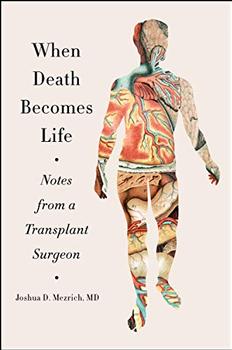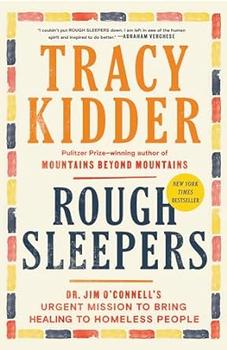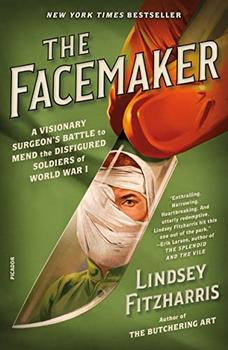Summary | Excerpt | Reviews | Beyond the book | Read-Alikes | Genres & Themes | Author Bio

Critics' Opinion:
Readers' Opinion:
First Published:
Jan 2019, 384 pages
Paperback:
Jan 2020, 384 pages
 Book Reviewed by:
Book Reviewed by:
Rebecca Foster
Buy This Book
Though it happened more than ten years ago, Joshua Mezrich still clearly remembers setting out in a six-seater plane – during a thunderstorm, in the middle of the night – to bring back the organs harvested from a young man who died in a motorcycle accident. The weather was so violent that he wasn't sure he was going to live to tell the tale. The incident makes for a dramatic opening to his wide-ranging book about the practice of transplanting organs, confirming that this really is a life and death business.
Mezrich grew up in New Jersey and now works in Madison, Wisconsin; he's been practicing surgery ever since his time at Cornell medical school in the late 1990s. In When Death Becomes Life, he intersperses stories from his career as a transplant surgeon with snapshots from the history of the science behind these procedures. For Mezrich's purposes, this history begins in 1894, when medical student Alexis Carrel, distressed at French president Marie-François-Sadi Carnot's death after being stabbed by an anarchist, began experiments to try to reconnect blood vessels in the hope that one day victims of similar injuries could be saved. The book leaps through time to focus on vivid scenes from the advancing research. Many of these cluster in the 1940s, when Dutch doctor Willem Kolff developed the first dialysis machine, British biologist Peter Medawar advanced the study of tissue culture, and American doctor David Hume grafted a kidney into a patient's thigh.
The history of transplantation – which is chiefly centered around the kidneys, heart, and liver – has been rocky. In the 1940s and 1950s, patient after patient was lost due to rejection of the transplanted organ, post-surgery infection, or hemorrhaging. The first successful kidney transplant wasn't until 1954, and that was between twin brothers. For a while, radiation and bone marrow transplantation were used as pre-treatments for transplant patients (the former to suppress the immune system's reaction against a foreign body; the latter to boost the immune system after the transplant), but usually they would die of infection anyway. We mostly have English researcher Roy Calne to thank for developing the drug cyclosporine from fungal spores. It provides highly reliable immunosuppression – keeping a patient's immune system from attacking the new organ.
Even though transplanting organs is now routine for him, Mezrich marvels at how few decades passed between transplantation seeming like something out of a science fiction future and becoming a commonplace procedure. His aim is to never lose his sense of wonder at the life-saving possibilities of organ donation, and he conveys that awe to readers through his descriptions of a typical procedure. In one early chapter he takes us through a kidney transplant step by step. Although it can be a little hard to picture what's going on (especially if, like me, you don't know your anatomy and medical terminology all that well), it's still a privileged insider's look into an everyday miracle.
My favorite sections of the book focus on the transplant patients and organ donors the author has known. Organs come either from cadavers (after circulatory or brain death) or live donors. Live-donor kidneys last nearly twice as long as those from cadavers, but Mezrich notes that it's important to ensure that donors know what they're getting into in terms of pain and recovery, and aren't being coerced in any way. Altruistic donors can participate in a nationwide paired organ exchange program – the longest-ever chain linking non-matching donors to suitable recipients, organized by the U.S. National Kidney Register, involved 34 people!
There are many touching stories here. One that stood out for me was that of Michaela, a young white woman who got a liver transplant from C.L., a young black man who died in a gang-related shooting, and then woke up wanting hamburgers – C.L.'s favorite food. (Science on cellular memory suggests a possible explanation for this phenomenon.) I was also invested in the story of Nate, one of Mezrich's colleagues. As a surgery trainee, Nate needed a liver transplant himself – performed by Mezrich – but he experienced the full gamut of complications. While he awaited a redo transplant, he gave an inspirational speech about hope at his medical school graduation, even though he was desperately ill.
Occasionally I lost interest in the historical material, especially because I'd already read quite a bit about the development of heart transplantation recently in Sandeep Jauhar's Heart: A History. I also bristled at the occasional frat-boy jokiness of Mezrich's tone (i.e. when he is listening to Tupac Shakur and cracking jokes, referring to surgery as "ballsy"). All in all, though, I found this to be a valuable account of a key chapter from medical history. Mezrich moves smoothly between the different strands of his narrative, with the historical material as accessible as the autobiographical. I recommend this to anyone who enjoys medical-themed reads, though it may well mean the most to those who have a personal connection to organ donation. For instance, I have polycystic kidney disease, a progressive genetic condition that often leads to kidney failure. Many members of my extended family have benefited from kidney transplants, and one day I will likely need a donated kidney to save my life. How grateful I am to live at a time when this is a possibility.
![]() This review was originally published in The BookBrowse Review in February 2019, and has been updated for the
January 2020 edition.
Click here to go to this issue.
This review was originally published in The BookBrowse Review in February 2019, and has been updated for the
January 2020 edition.
Click here to go to this issue.

If you liked When Death Becomes Life, try these:

by Tracy Kidder
Published 2024
The powerful story of an inspiring doctor who made a difference, by helping to create a program to care for Boston's homeless community—by the Pulitzer Prize–winning, New York Times bestselling author of Mountains Beyond Mountains

by Lindsey Fitzharris
Published 2023
Lindsey Fitzharris, the award-winning author of The Butchering Art, presents the compelling, true story of a visionary surgeon who rebuilt the faces of the First World War's injured heroes, and in the process ushered in the modern era of plastic surgery.





The House on Biscayne Bay
by Chanel Cleeton
As death stalks a gothic mansion in Miami, the lives of two women intertwine as the past and present collide.

The Flower Sisters
by Michelle Collins Anderson
From the new Fannie Flagg of the Ozarks, a richly-woven story of family, forgiveness, and reinvention.

The Funeral Cryer by Wenyan Lu
Debut novelist Wenyan Lu brings us this witty yet profound story about one woman's midlife reawakening in contemporary rural China.
Your guide toexceptional books
BookBrowse seeks out and recommends the best in contemporary fiction and nonfiction—books that not only engage and entertain but also deepen our understanding of ourselves and the world around us.